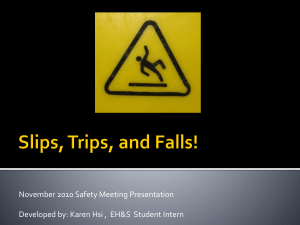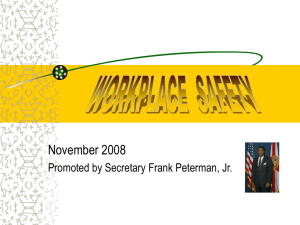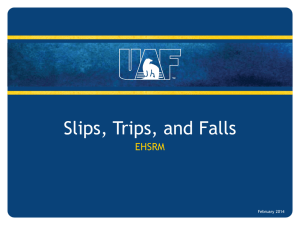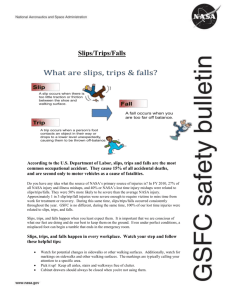Slips, Trips, and Falls Revised 9/16/15
advertisement
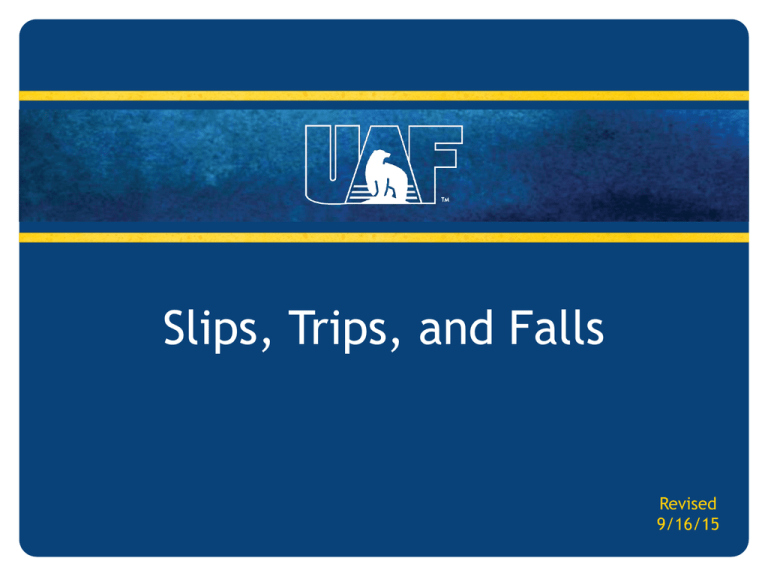
Slips, Trips, and Falls Revised 9/16/15 Slips, Trips, and Falls •Target Audience –All UAF employees •Objectives –Increase employee awareness to recognize slip, trip, and fall hazards at UAF –Encourage employee participation in identifying, reporting, and preventing injuries caused by slips, trips, and falls See something, say something, do something 2 Slips, Trips, and Falls •Learning Objectives –General –UAF slips, trips and falls –Costs of slips, trips and falls –Definitions –Circumstances associated with slips, trips, falls –Risk factors –Types of injuries –Prevention –Reporting 3 Slips, Trips, and Falls - General •Majority of general industry accidents are caused by slips, trips and falls •Slips, trips and falls cause 15% of all accidental deaths, and are the second leading cause behind motor vehicle accidents •Slips, trips, and falls can occur anywhere in your work environment •Can result in permanent disability and even death 4 Costs of Slips, Trips, and Falls •To the employee –Lost wages –Pain and suffering, embarrassment –Temporary or permanent disability –Reduced quality of life –Death •To the employer –Loss of productivity –Costs for overtime or training for replacement worker –Increased insurance premiums 5 UAF Slips, Trips, and Falls •32% of all injuries at UAF are slips, trips and falls •Average annual costs due to workman’s comp claims at UAF: approximately $282,000 •Average annual total employee days away from work: 135 days 6 UAF Slips, Trips, and Falls (cont.) •In 2013, we had –65 reported slips, trips, and falls •47 outside, 12 inside, 6 were falls from equipment •28 of the 47 outside occurred during months when ice and snow are normally present •In 2014, we had –40 reported slips, trips and falls •31 were outside, 9 inside •26 of the 31 outside occurred during months when ice and snow are normally present 7 Definitions •Slip –Lack of friction or traction between footwear and walking or working surface that results in loss of balance 8 Definitions (cont.) •Trip –Foot or lower leg hitting an object and the upper body continues to move forward resulting in loss of balance 9 Definitions (cont.) •Fall –A fall occurs when you loose your balance or bodily support Two types of Falls –Fall at same level •Fall to same walking or working surface, or •Fall into or against objects above the same surface –Fall to lower level •Fall to level below walking or working surface 10 Slip Circumstances •Wet areas on walking surfaces •Dry products on walking surface •Freshly waxed surfaces •Icy walk ways •Transitioning from one surface to another •Sloped walking surfaces •Mounting and dismounting vehicles and equipment •Loose, irregular surfaces such as gravel •Improper tread on footwear 11 Trip Circumstances •Uneven surfaces •Sidewalk/curb drops •Wheelchair ramps and curbs •Uncovered cables, wires or extension cords across aisles or walkways. •Clutter or obstacles in aisles or walkways •Open file cabinet or desk drawer •Irregularities in walking surfaces •Damaged steps on stairways •Elevator not level 12 Fall Circumstances •Slipping or tripping •Not utilizing fall protection when necessary •Improper use of ladders •Inattention to surroundings •Condition of ground surfaces - Icy, wet, uneven, cluttered with debris •Improperly mounting/dismounting of equipment or vehicles •Loss of balance •Unprotected edges 13 Risk Factors – Environmental Conditions Icy Surfaces Snow Buildup on Stairs Poor Lighting 14 Risk Factors - Environmental Conditions Fog or misty conditions Poor Housekeeping 15 Risk Factors – Human •Carrying objects that –Obstruct your view –Do not leave a free hand •Lack of situational awareness –Texting and walking or listening to music –Talking on cell phones while walking •In a hurry or taking shortcuts •Failing eyesight or visual perception •Age •Physical/medical conditions 16 Risk Factors – Human (cont.) Lack of Fall Protection Equipment Improper Use of Ladders 17 Types of Slip, Trip & Fall Injuries •Back and neck injuries •Head injuries •Muscle injuries •Joint injuries •Broken bones 18 Prevention: Identify the Hazards in the Photos 19 Prevention – Hazards Identified Snow on stairs creating an uneven surface Water on floor Cord in walkway Broom sticking out Stair tread pealed up 20 Prevention (cont.) •Use the Origami System to file an Unsafe Condition Report to report damaged walking surfaces (stairs, sidewalks, etc.) •Wear proper footwear with good traction •Use hand rails when using stairways •Complete required trainings •Be aware of your surroundings Remove clutter from walkways Utilize fall protection Wear ice cleats 21 UAF Ice Cleat Program Ice cleats are provided free of charge to all employees and students who request them How to obtain ice cleats •Pick up at EHSRM office 1855 Marika Road •Bulk order 10 or more for your office using online order form (Sept. 1st – Nov. 15th) •Remote locations can order directly using loss prevention funding. Contact EHSRM for additional details. Reporting Reminders •To report all accidents and injuries, use Origami to file an online incident reporting link found on our website. •Use Origami to file an online unsafe condition report to report any workplace condition or damage that might create a slip, trip, fall hazard. Remember if you report an unsafe condition you are automatically entered into a quarterly incentive award drawing! •To report icy conditions that need immediate attention, please contact Facility Services directly at 474-7000 or dispatch@fs.uaf.edu or snowremoval@fs.uaf.edu 22 Contact Information Main Line 474-5413 Ice Cleats Kim Knudsen 474-6164 klamb1@alaska.edu Occupational Safety Gary Beaudette 474-2763 gsbeaudette@alaska.edu Kim Knudsen 474-5476 klamb1@alaska.edu www.uaf.edu/safety/ 23
